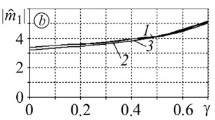Abstract
Based on the analysis of solutions to differential equations of longitudinal vibrations of a macroelastic body whose nonlinearity is due to “breathing” of the damaged material under tension-compression cycling, we estimate the suitability of the deformation-cycle characteristic of a body under free and forced vibrations for the diagnostics of fatigue damage in structural elements. We consider the following problems: the construction of a simplified model of longitudinal vibrations of mechanical elements with cross cracks, the investigation of free vibrations of a cracked body including resistance forces, the forced vibrations of a cracked body taking into account a perturbation force including and excluding resistance forces, and the study of vibrations of a beam with resistance different from the linear one. We show that the presence of a macrocrack is responsible for the occurrence of representative higher harmonics in the deformation-cycle spectrum. They can serve as a sensitive and efficient vibration-diagnostic parameter to detect cracks in structural elements.
Similar content being viewed by others
References
V. V. Matveev, “On the validity of using strain criteria of high-cycle fatigue fracture of metals. Part 2. A new approach,”Probl. Prochn., No.3, 3–12 (1995).
V. V. Matveev, “On analysis of the efficiency of the method of spectral vibration diagnostics of fatigue damage of structural elements. Part 1. Longitudinal vibrations. Analytical solution,”Probl. Prochn., No.6, 5–20 (1997).
V. S. Ivanova and V. F. Terentyev,The Nature of Fatigue of Metals [in Russian], Metallurgiya, Moscow (1975).
V. P. Butseroga, “Equipment for experimental study of fatigue crack development,”Probl. Prochn., No.2, 110–119 (1996).
B. I. Kryukov,Dynamics of Resonance-Type Vibration Machines [in Russian], Naukova Dumka, Kiev (1967).
S. Maezawa, “Superharmonic resonance in a piecewise-linear system with unsymmetrical characteristics,” in: Proc. Vth Intern. Conf. on Nonlinear Vibrations [in Russian], Vol. 1, AN UkrSSR, Kiev (1970), pp. 401–422.
V. A. Karasev and A. B. Roitman,Operational Development of Machines. Vibration Diagnostic Methods [in Russian], Mashinostroenie, Moscow (1986).
G. S. Pisarenko, A. P. Yakovlev, and V. V. Matveev,Vibration Damping Properties of Structural Materials [in Russian], Naukova Dumka, Kiev (1971).
V. L. Biderman,Applied Theory of Vibrations [in Russian], Vysshaya Shkola, Moscow (1972).
V. L. Biderman,Theory of Vibrations [in Russian], Vysshaya Shkola, Moscow (1980).
Additional information
Zaporozh'e State University, Zaporozh'e, Ukraine. Translated from Problemy Prochnosti, No. 2, pp. 23–34, March–April, 1999.
Rights and permissions
About this article
Cite this article
Roitman, A.B., Pylov, A.A. & Aleksandrova, N.B. Longitudinal vibrations of a cross-cracked cantilever beam. Part 1. Small vibrations. Strength Mater 31, 120–129 (1999). https://doi.org/10.1007/BF02511101
Received:
Issue Date:
DOI: https://doi.org/10.1007/BF02511101




